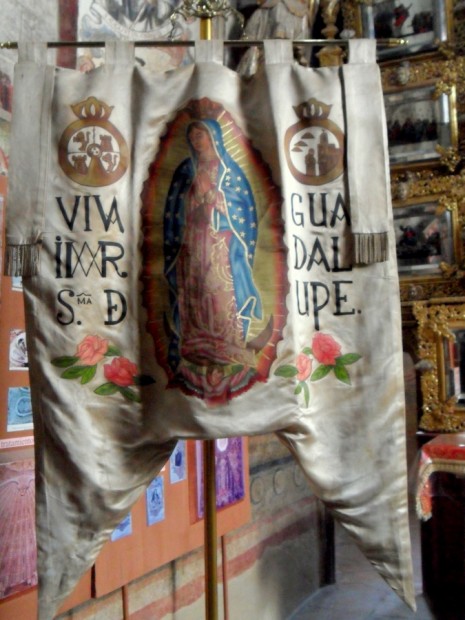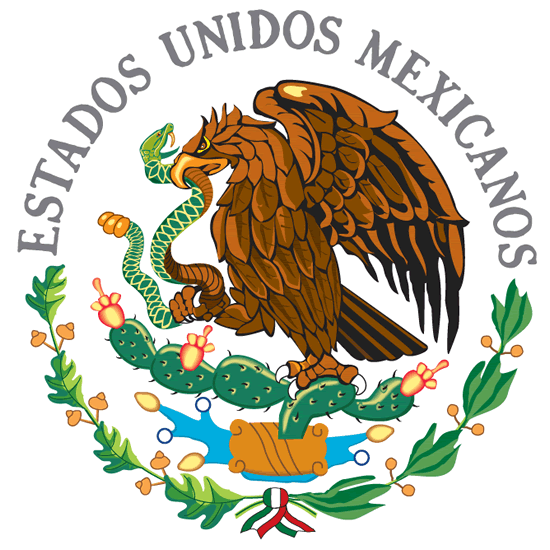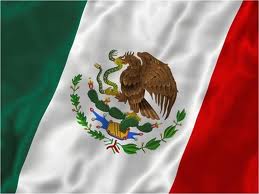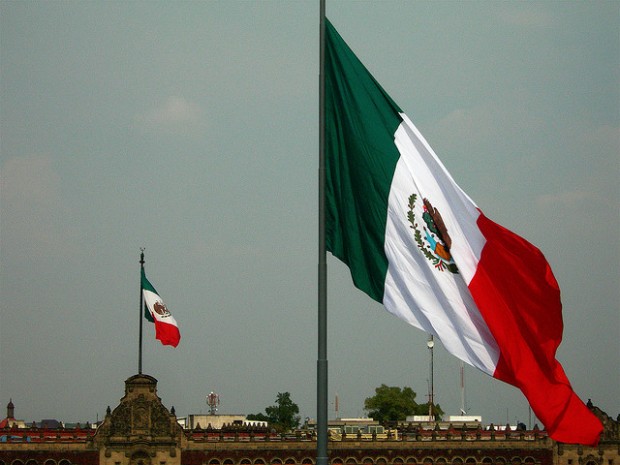By MoKa Hammeken
 February 24th is a solemn day as it is the day dedicated to one of the most important patriotic symbols of Mexico, which gives the spirit of unity and belonging to Mexicans either within or outside of the country: the Flag. Mexico’s flag is well-known internationally by its colors and coat of arms.
February 24th is a solemn day as it is the day dedicated to one of the most important patriotic symbols of Mexico, which gives the spirit of unity and belonging to Mexicans either within or outside of the country: the Flag. Mexico’s flag is well-known internationally by its colors and coat of arms.
The flag waves fervently during festivals and moments of national pride. Yet, this banner does more than simply identify us as fans of any sports team; it has signified the ideals, victories, and efforts to build an independent nation.
 Many historians consider the famous banner of Miguel Hidalgo (Virgen de Guadalupe), waved during the famous “grito de Dolores” (cry for Independence), as the first Mexican flag. This was on September 16, 1810. In 1813, the insurgents came up with another design, which became the flag that accompanied María Morelos y Pavón in his struggles; it was a blue rectangle with another white rectangle and in the center a crowned eagle perched on a nopal cactus, above there was a door with three arches and the initials “VVM” (Viva la Virgen María). [The significance of the eagle perched on a nopal is representative of an ancient Aztec legend of God telling wandering Aztecs that when they came across an eagle eating a snake while perched on a nopal cactus growing out of a rock surrounded by water, that is where they were to build their home. That spot became Tenochtitlán, or rather modern day Mexico City.]
Many historians consider the famous banner of Miguel Hidalgo (Virgen de Guadalupe), waved during the famous “grito de Dolores” (cry for Independence), as the first Mexican flag. This was on September 16, 1810. In 1813, the insurgents came up with another design, which became the flag that accompanied María Morelos y Pavón in his struggles; it was a blue rectangle with another white rectangle and in the center a crowned eagle perched on a nopal cactus, above there was a door with three arches and the initials “VVM” (Viva la Virgen María). [The significance of the eagle perched on a nopal is representative of an ancient Aztec legend of God telling wandering Aztecs that when they came across an eagle eating a snake while perched on a nopal cactus growing out of a rock surrounded by water, that is where they were to build their home. That spot became Tenochtitlán, or rather modern day Mexico City.]
It was not until 11 years later that, following the Plan de Iguala that brought together the troops of Agustín de Iturbide and Vicente Guerrero to create the Trigarante Army, would the struggle for independence come to an end. It was then on February 24th when Iturbide decided to create a flag that would reflect the ideals of the Insurgent movement, contracting the tailor José Magdaleno Ocampo to make a tri-color flag with diagonal stripes. Each color had its own meaning: white – the purity of the Catholic religion (which was the State religion until the constitution of 1857), green – representing the Insurgents movement (also known as the Independence), and finally red – representing the Spanish group adhering to the liberating impulse. Nevertheless, this still did not carry the emblematic national coat of arms.
That same year, on November 2nd, when the Trigarante Army victoriously entered Mexico City, Iturbide decreed the Mexican flag be made up of the same colors yet with vertical stripes and in the order that continues today: green, white, and red. In the center was placed an eagle wearing an imperial crown, with wings down and perched on a nopal cactus.
Even so, this emblem was not pleasing following the Iturbide empire and in 1823 the eagle lost its imperial crown, which was replaced with branches of oak and laurel as a symbol of the Republic.
 Over the years the eagle has changed positions on various occasions, yet it was not until 1916, when President Venustiano Carranza decreed the flag recover its former style, that its profile was shown with it devouring a snake and perched on a nopal cactus.
Over the years the eagle has changed positions on various occasions, yet it was not until 1916, when President Venustiano Carranza decreed the flag recover its former style, that its profile was shown with it devouring a snake and perched on a nopal cactus.
The version of the flag that waves overhead across the nation today is an adaptation of the Carranza design (changing the profile of the eagle), which was decreed as such on Dec. 27, 1967, just in time for the Olympic games hosted by Mexico.
Since 1937, the date of Feb. 24th (officially recognized in 1940 by President Lázaro Cárdenas) has been publicly commemorated in front of the monument to General Don Vicente Guerrero who was the first Mexican military official to swear before the flag during an event known as “The embrace of Acatempan” on March 12, 1821.
This is how we came to have the memorable national symbol that flies when we feel proud of our roots, victories, language, and culture and that helps identify us even when we are far from home.
Por MoKa Hammeken
El Día de la Bandera
Este 24 de febrero es un día solemne, pues es el día dedicado a uno de los más importantes símbolos patrios de México, que le da espíritu de unidad y pertenencia al mexicano, dentro y fuera de su país: Su bandera, bien conocida internacionalmente por sus colores y su escudo.
Es muy ondeada durante fiestas y momentos de orgullo nacional, pero este estandarte hace más que identificarnos como fans de un equipo deportivo. Ha significado ideales, victorias y esfuerzos por construir una nación independiente.
Muchos historiadores consideran el famoso estandarte de Miguel Hidalgo (la virgen de Guadalupe), durante el famoso grito de Dolores (en la independencia), como la primera bandera de México. Esto fue el 16 de septiembre de 1810. En 1813 los insurgentes idearon otro diseño y la bandera que acompaño a María Morelos y Pavón en su lucha, era un rectángulo de color azul con otro de color blanco que tenía en el centro un águila coronada que posaba sobre un nopal, encima de un puente de tres arcos con las iniciales “VVM” (Viva la Virgen María).
Pero no fue si no hasta 11 años después que, apartir del plan de Iguala donde al unirse las tropas de Agustín de Iturbide y Vicente Guerrero se creó el Ejército Trigarante, que habría de poner fin a la lucha por la independencia. Es entonces, el 24 de febrero, cuando Iturbide decidió formar una bandera que reflejara los ideales del movimiento inlsurgente, y para tal fin acudió al sastre José Magdaleno Ocampo que confeccionó una bandera tricolor con franjas en diagonal donde cada color tenía un significado: el blanco, la pureza de la religión católica (que fue religión de estado hasta la promulgación de la constitución del 1857); el verde el movimiento insurgente ( también conocido como la independencia) y finalmente, el rojo, representa al grupo español adherido al impulso libertador. Sin embargo está aún no portaba el emblemático escudo nacional.
Ese mismo año, pero el 2 de noviembre, cuando el ejército Trigarante entró victorioso en la Ciudad de México, Iturbide decretó que la bandera de México fuese con los mismos colores, pero con las franjas verticales y en el orden que perdura hasta nuestros días, verde, blanco y rojo, colocándose al centro el águila con corona imperial, las alas caídas y posada sobre un nopal.
Aún así este emblema no fue de mucho agrado cuando cayo el imperio de Iturbide y en 1823 se le espojó al ágila de su corona imperial y se le agregaron al escudo las ramas de encino y de laurel como símbolo de la República.
Con el transcurso de los años el águila ha cambiado de posiciones en varias ocasiones, pero fue hasta 1916, cuando el Presidente Venustiano Carranza decretó que recobrara su antiguo estilo, de perfil y devorando una serpiente sobre el nopal.
La versión que ondea hoy en las astas de todo el territorio nacional es una adaptación del diseño de Carranza (cambio de perfil del águila), decretada el 27 de diciembre de 1967, justo a tiempo para los Juegos olímpicos en los cuales México sería el anfitrión .
Desde 1937 se conmemora públicamente esta fecha (festividad reconocida en 1940, por el decreto del Presidente Lázaro Cárdenas) ante el monumento del General Don Vicente Guerrero, que fue el primer militar mexicano que juró ante la Bandera, en el evento conocido como el abrazo de Acatempan, del 12 de marzo de 1821.
Y es así como llegamos a tener un memorable símbolo nacional que ondeamos cuando nos sentimos orgullosos de nuestras raíces, victorias, lengua y cultura que nos ayuda a identificarnos aún cuando estemos lejos de casa.

